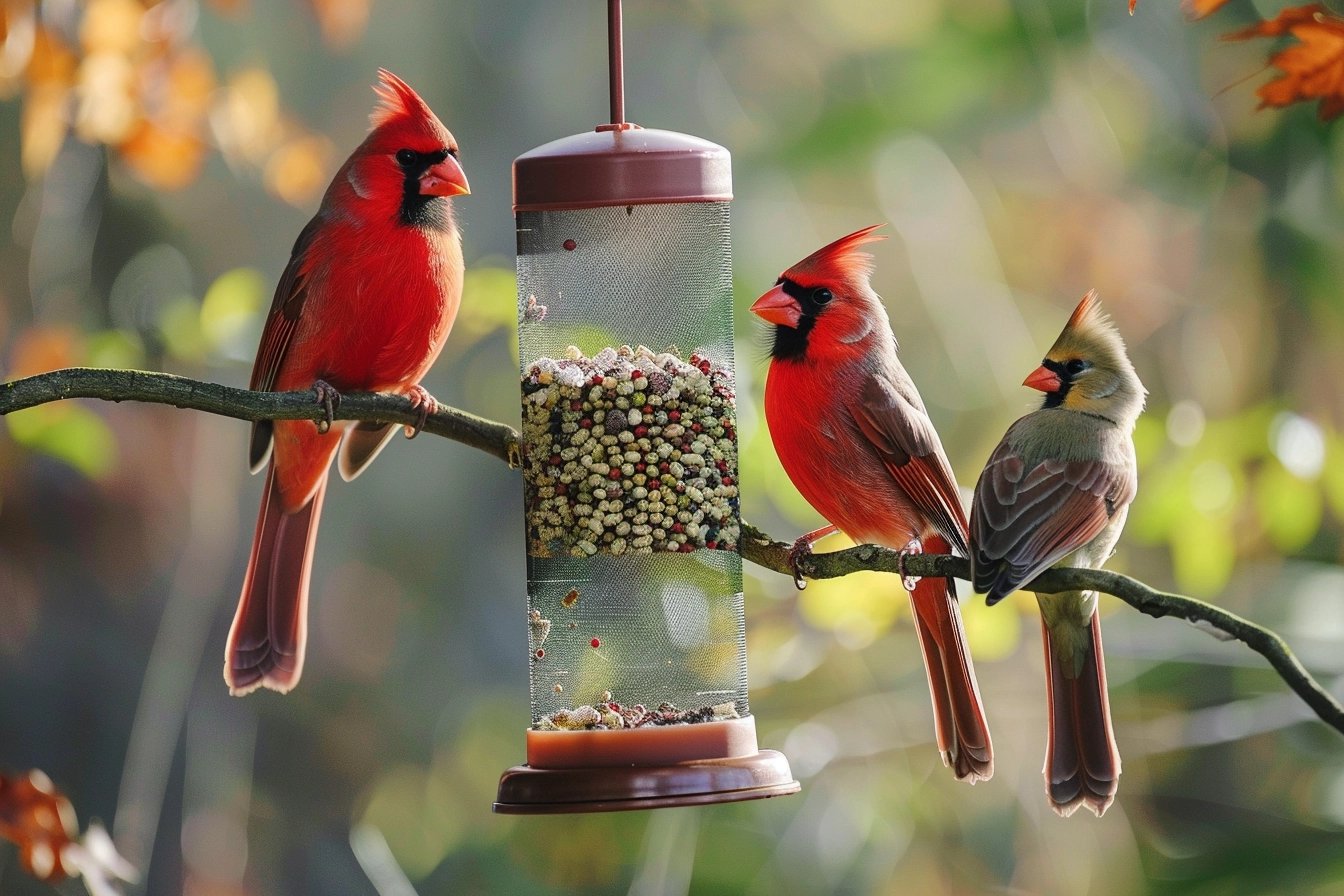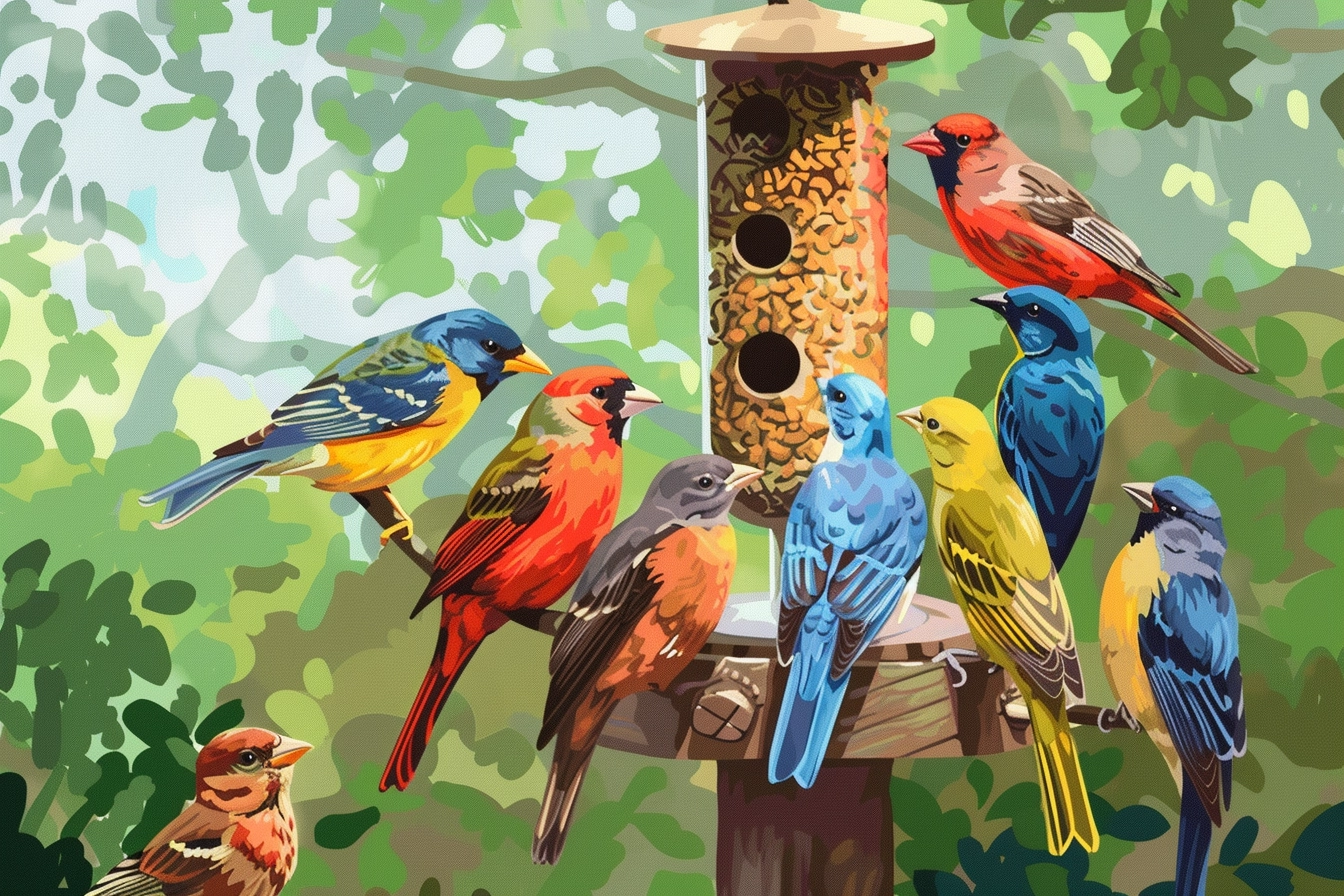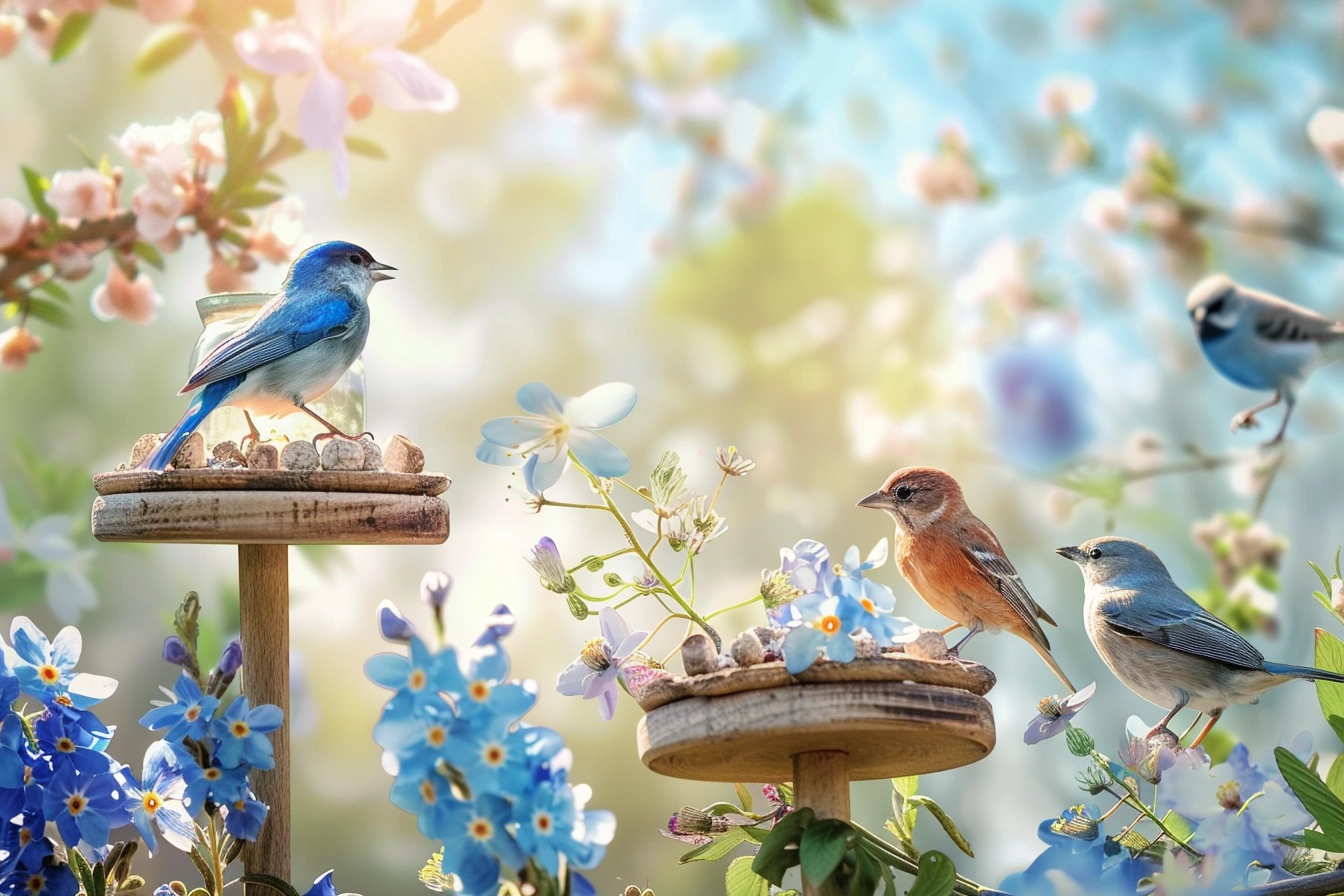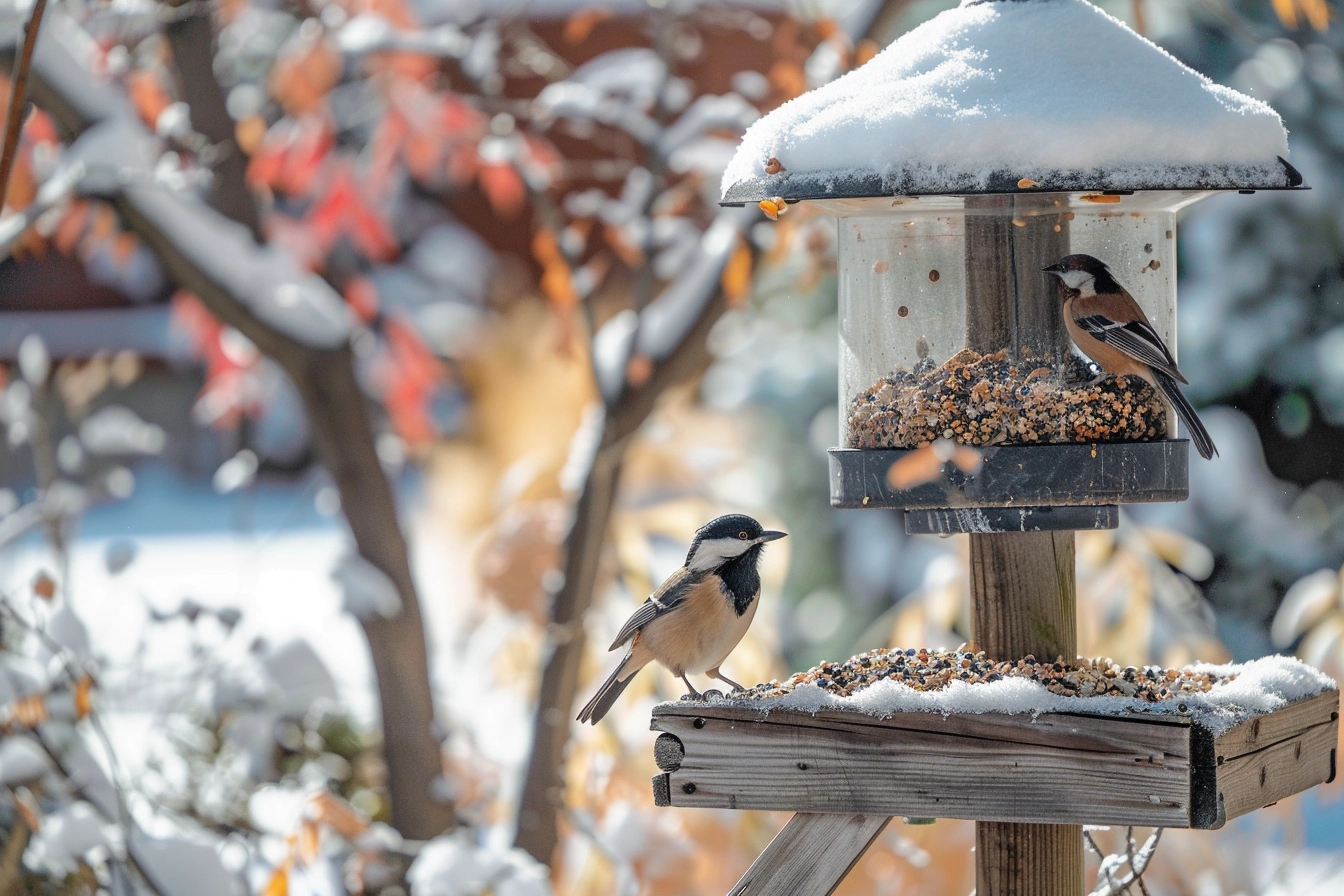If you’re looking to bring a lively chorus of chirps and tweets to your garden, attracting birds to your bird feeder can be a rewarding endeavor.
Birds not only add beauty and entertainment to your outdoor space, but they also play an essential role in the ecosystem by pollinating plants and controlling insect populations.
To entice these feathered friends to your feeder, you’ll need to understand what appeals to them, from food preferences to feeder styles and placement.
Creating an inviting habitat for birds involves more than just hanging a feeder and waiting.
Selecting the right feeder and food to cater to the desired bird species is crucial. Different birds have different dietary needs and feeder preferences.

Key Takeaways
- Attracting birds requires a combination of the right feeder, food selection, and feeder placement.
- A safe environment and regular maintenance are essential to keep birds returning.
- Deterrent strategies for pests enhance the bird-watching experience and support bird health.
Choosing the Right Bird Feeder
Selecting a bird feeder that meets both your needs and those of the birds can significantly enhance your bird watching experience.
Learn about the different types of feeders and how placement is key to a lively bird presence in your yard.
Types of Feeders
Tube Feeders:
Best suited for small birds like finches, tube feeders keep the seed relatively dry. Ensure the model has metal feeding ports to deter squirrels.
Suet Feeders:
Designed for suet cakes, these attract birds that enjoy fats, such as woodpeckers and nuthatches. They can be either cage-like or a simple mesh bag.
Hopper Feeders:
Sturdy and sizeable, hopper feeders are great for a wide variety of birds. They protect the seeds well against the elements but require regular cleaning to prevent mold and bacteria growth.
Platform Feeders:
These are open feeders that can attract both small and large birds, including some that may not visit other types of feeders. Their downside is that they offer no protection against weather and squirrels.
Thistle Feeders:
Narrow and with small feeding holes, thistle feeders are specifically forneverr seeds favored by finches and siskins.
When introducing a new feeder, consider starting with a universal seed like black oil sunflower to attract a broad range of birds until you can gauge the prevalent species in your area.
Feeder Placement
Location is crucial when you’re setting up your bird feeder.
- Visibility: Place the feeder where it is easily visible to birds and from your viewing spot.
- Safety: Keep feeders away from busy walkways to avoid startling the birds, and position them close enough to shelter (like trees or shrubs) to offer protection from predators.
- Maintenance: Make sure the feeder is accessible for cleaning and refilling.
Selecting the Best Food
Selecting the right types of bird food is crucial to attract a variety of birds to your feeder. Premium quality food will entice a diverse avian population and ensure their return.
Seeds and Nuts
Seeds should be the foundation of your feeders.
Black oil sunflower seed is a favorite among birds like cardinals and titmice due to its high fat content and easy-to-crack shells. For smaller birds like finches and sparrows, offer nyjer seed or thistle seed in a specialized feeder.
Additionally, diverse blends can include safflower seed, loved by chickadees but less appealing to squirrels, and millet, which is excellent for ground-feeding birds.
Peanuts, either whole or crushed, are a high-energy source and attract larger birds such as jays.
- Sunflower seeds: A universal favorite.
- Nyjer and thistle: Specially loved by finches.
- Safflower: Less appealing to squirrels.
- Peanuts: Great for protein and fat content.
Suet and Insects
During colder months, suet—a hard fat often mixed with seeds or grains—is invaluable for providing birds with the calories they need to maintain their body heat.
Offering suet in a secure cage feeder will bring in insectivorous birds that don’t ordinarily visit seed feeders, such as woodpeckers and nuthatches.
Mealworms, either live or dried, are a protein-rich food source ideal for bird species that crave insects.
- Suet: Essential for winter feeding.
- Mealworms: High protein for birds that prefer insects.
Fruits and Nectar
Fruit can be offered fresh or dried; orange slices, raisins, or apple pieces are favored by orioles and tanagers.
Nectar, mainly associated with attracting hummingbirds, should be free of dyes and consist of a simple homemade solution of sugar and water.
Creating a nectar feeder setup during the spring and summer can provide a vital source of energy for these flying jewels.
- Fresh fruit: Attracts fruit-loving birds.
- Nectar: Simple sugar solution for hummingbirds.

Attracting Various Bird Species
To maximize the allure of your feeder for a broad range of birds, it’s essential to understand their unique preferences.
Having the right feed solution and feeder type can turn your garden into a hub of avian activity.
Attracting Small Birds
Small bird species, such as finches, chickadees, nuthatches, and titmice, prefer feeders that use seeds suited to their small beaks.
Sunflower seeds are a favorite for many, drawing in a lively variety.
A variety of foods can be offered such as millet for ground feeding birds like sparrows and doves.
Positioning your feeders near protective cover helps small birds feel secure to dine at your offering.
- Preferred Feeder Types for Small Birds:
- Tube Feeders: Ideal for finches and titmice.
- Hopper Feeders: Attract a variety of small birds.
- Platform Feeders: Good for chickadees and nuthatches.
Attracting Hummingbirds
Hummingbirds are enticed by bright colors and sweet nectar.
Use a red or pink feeder filled with a simple sugar solution—four parts water to one part white sugar—to mimic natural nectar. Avoid using red dye in the solution.
Best to place feeders where you can easily view these vibrant visitors.
- Preparation for Nectar Solution:
- Mix 1/4 cup of sugar with 1 cup of water.
- Boil the solution to remove impurities and let it cool before filling the feeder.
Attracting Woodpeckers
Woodpeckers, including downy, hairy, and red-bellied species, are drawn to feeders offering suet and nuts.
A suet feeder, particularly one with a tail prop area, accommodates their feeding style.
Peanuts and tree nuts are also a hit with these birds; a peanut feeder can provide hours of entertainment as woodpeckers work to extract their treat.
Best Foods for Woodpeckers:
- Suet Blocks: High in fat, perfect for energy.
- Shelled Nuts: A favored protein source.
Creating a Safe and Welcoming Environment
To attract birds to your feeder successfully, you need to establish a haven that offers safety and comfort. Below are specific tactics to achieve this.
Natural Shelter and Cover
Your garden should have a variety of trees and shrubs to provide natural shelter and cover for birds.
Dense shrub varieties and evergreens can offer excellent protection from weather and predators, allowing birds to feel secure and stay longer.
Incorporating native plants in your habitat not only offers shelter but also a natural source of food and materials for nesting.
- Trees: Place feeders near deciduous and coniferous trees for birds to have quick escape routes.
- Shrubs: Layer your garden with shrubs of different heights to cater to different bird species.
Protection from Predators
To make your bird feeder a safe spot, you must mitigate the risks from predators like cats and hawks.
- Location: Position feeders about 10-12 feet away from potential predator hideouts like tall fences and thick bushes. This distance gives birds enough time to react and escape.
- Visibility: Ensure the feeding area is visible to birds from their shelter so they can scout for danger while eating.
Bird Baths and Water Features
A reliable water source is a major draw for birds, not just for drinking but also for bathing.
A clean and shallow bird bath or a gently flowing water feature can be irresistible to birds.
- Bird Bath Placement: Keep your bird bath in a place where birds have a clear view of the surroundings but can dart to cover if needed.
- Cleaning: Maintain hygiene by cleaning the bird baths regularly to prevent the spread of disease.

Positioning Your Feeder Effectively
Choosing the right location for your bird feeder can make all the difference in attracting a variety of birds and ensuring their safety.
Not only does the position affect visibility for the birds, but it also involves protecting them from potential hazards.
Ideal Placement
When positioning your bird feeder, consider the distance from trees and shrubs that can provide natural cover and perching opportunities for the birds.
Placing the feeder about 10-12 feet from such natural shelters is often ideal. This distance is close enough to offer birds a quick escape from predators but also far enough to reduce the risk of a predator waiting in ambush.
It’s also important to place feeders in a location that receives a mix of sun and shade throughout the day.
This ensures the food remains fresh longer by minimizing spoilage.
If you have a backyard, centering the feeder in an area with good visibility lets you enjoy bird-watching from a comfortable vantage point while staying out of the birds’ direct line of sight.
Avoiding Window Collisions
Windows can be a significant hazard for birds.
To prevent collisions, it’s prudent to set up your feeder either less than 3 feet from a window or more than 30 feet away.
The former prevents birds from gaining enough momentum to harm themselves if they do hit the window, while the latter allows them enough reaction time to avoid the window altogether.
For additional safety, consider applying decals or other visual markers to your windows to make them more noticeable to birds. This advice aligns with guidelines provided by expert sources on bird feeder setup.

Deterring Unwanted Guests
To attract a variety of birds to your feeder, it’s essential to ensure that the seeds and feed are secure from non-avian wildlife.
Predators and pests like squirrels and cats can deter your feathered friends, so let’s focus on keeping these unwanted guests at bay.
Squirrel Proofing
A key strategy in keeping squirrels away from your bird feeder is the installation of a baffle. This is a dome-shaped or cylindrical barrier that prevents squirrels from accessing the feeder from above or below.
Position your feeder away from jump-off points, as squirrels can leap great distances. A metal baffle, placed both above and below your feeder, is often enough to deter squirrels effectively.
For the best results, ensure the feeder is at least 5 feet off the ground and 10 feet from any trees, walls, or fences.
Discouraging Larger Birds
- If larger birds are monopolizing your feeder, you can take a few steps to discourage them. First, adjust the size of the perches or use feeders with perches designed for smaller birds.
- Offering seeds that larger birds do not particularly enjoy, such as nyjer or safflower, can also discourage their visits.
- Additionally, caged bird feeders allow only small birds to enter and feed while keeping larger birds out.
- Be aware of the local bird species and their feeding habits. This knowledge can help you select the right feeder design to attract your desired guests.
